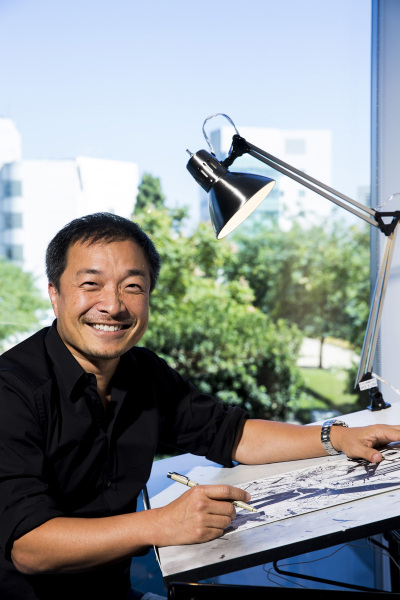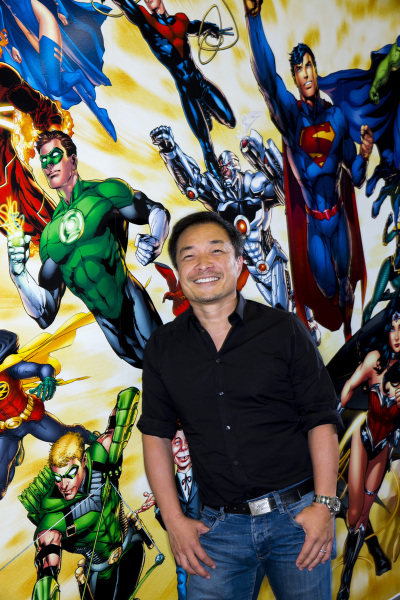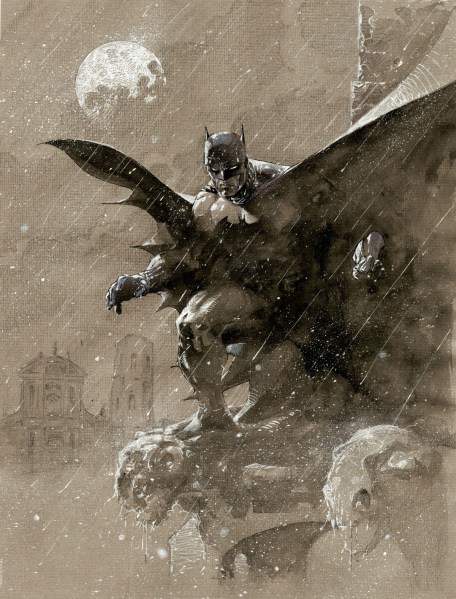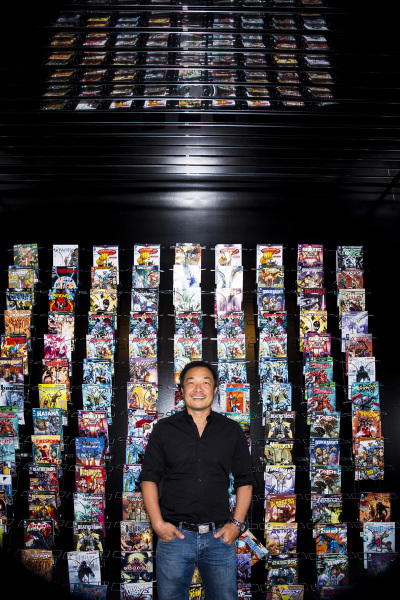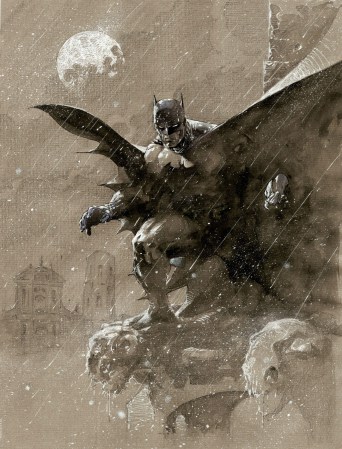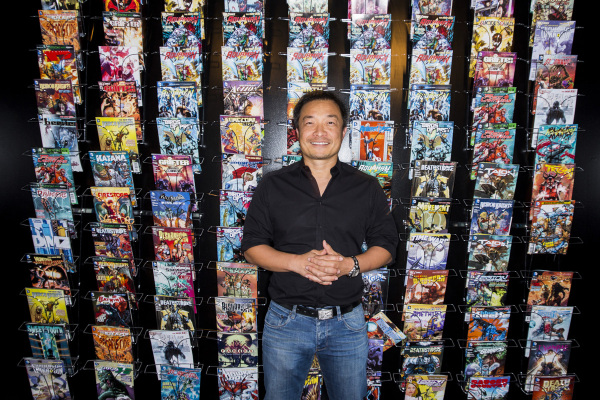
DC Comics co-publisher and comics heavyweight Jim Lee is photographed at DC Entertainment's headquarters in Burbank, Calif., on Oct. 1, 2013. (Jay L. Clendenin / Los Angeles Times)
DC Comics co-publisher and comics heavyweight Jim Lee is photographed at the drawing table in his office at DC Entertainment's headquarters in Burbank, Calif., on Oct. 1, 2013. (Jay L. Clendenin / Los Angeles Times)
DC Comics co-publisher and comics heavyweight Jim Lee is photographed at the drawing table in his office at DC Entertainment's headquarters in Burbank, Calif., on Oct. 1, 2013. (Jay L. Clendenin / Los Angeles Times)
DC Comics co-publisher and comics heavyweight Jim Lee is photographed at DC Entertainment's headquarters in Burbank, Calif., on Oct. 1, 2013. (Jay L. Clendenin / Los Angeles Times)
Piazza San Prospero in Italy served as an inspiration for one of Jim Lee's drawings of Batman. (Courtesy Jim Lee / DC Entertainment)
Piazza San Prospero in Italy served as an inspiration for one of Jim Lee's drawings of Batman. (Courtesy Jim Lee / DC Entertainment)
DC Comics co-publisher and comics heavyweight Jim Lee is photographed at DC Entertainment's headquarters in Burbank, Calif., on Oct. 1, 2013. (Jay L. Clendenin / Los Angeles Times)
This post has been corrected, as detailed below.
Jim Lee is no small name in the world of comics. With more than 25 years in the industry, Lee has worked on “Batman,” “Superman,” “Fantastic Four,” “X-Men,” “Punisher: War Journal” and dozens of other titles across publishers.
The San Diego-based artist first made his mark in the Marvel world; 1991′s “X-Men” No. 1, penciled by Lee and co-written with Chris Claremont, sold a record-breaking 8 million copies. In 1992, Lee and six other artists co-founded Image Comics, and Lee formed WildStorm Productions (later sold to DC). Lee returned to Marvel in 1996 before moving to DC Comics in 1998. There, his story arc “Batman: Hush,” written by Jeph Loeb, became a massive success, critically as well as commercially.
In 2010, Lee was named DC Comics co-publisher along with Dan DiDio, and together they plotted a relaunch of its superhero titles, with a clean slate and 52 new issue No. 1′s in 2011. The reboot kicked off with a new “Justice League” series, written by Geoff Johns and illustrated by Lee. Lee is currently working on “Superman Unchained,” which will run for nine issues (No. 4 lands Oct. 30), he told the Los Angeles Times.
Irene Lacher talked to him for The Times Calendar section’s Sunday Conversation about DC projects, villain psychology and his time in Italy’s influence on his work.
HC: What did DC do for Villains Month?
JL: Across the 52 books we published in September, we did these very cool 3-D motion covers that spotlight the villains actually taking over the hero’s book, so instead of it being called Batman, you’ll see “Joker” scrawled over the logo. And then Warner Bros. Home Entertainment also did a documentary called “Necessary Evil: Super-Villains of DC Comics.”
HC: You modernized your characters a couple of years ago when you relaunched all of your series as the New 52. What makes a villain modern?
JL: What you’ve seen over these decades is less of a black and white between the heroes and villains. Back in the ’30s, ’40s and ’50s, you had clear-cut heroes, clear-cut supervillains. Today, you have more of a blend, more of a gray area between the two. You have the rise of the sympathetic villain and the rise of the antihero. You have a lot of characters who follow the motto “The ends justify the means,” and depending on what the ends are, are they a villain or a superhero? That’s what makes supervillains today more modern. We’ll show their back story, we’ll show their motivation. It’s not just about robbing a bank of $10 million. They’re a lot more complicated and layered and thematically rich today than they were in the past.
DC Comics co-publisher and comics heavyweight Jim Lee is photographed at the drawing table in his office at DC Entertainment’s headquarters in Burbank, Calif., on Oct. 1, 2013. (Jay L. Clendenin / Los Angeles Times)
HC: Since villains are designed to reflect our anxieties, have 9/11 and the recent economic meltdown had any effect on the DC universe?
JL: Certainly, there are more stories that deal with terrorism and looking at the 1% as possible candidates for supervillains. In the ’50s, a lot of stories were built around radiation and the proliferation of new technology. In the ’70s, there were a lot of stories that dealt with the Vietnam War. So comic books have always been a reflection of the times we live in.
We are publishing a book called “The Movement” that has a lot of thematic resonance to the Occupy movement and characters really standing up for what’s right and making a difference in the world.
HC: Artistry has really come a long way since I was reading comic books; some look like they could have been drawn by Francis Bacon. Have artists like Bacon had a direct influence?
JL: Everyone draws inspiration from different talents. There are a lot of people influenced by artists from the Victorian era, the Hudson Valley artist movement. Gustav Klimt is another guy who has influenced a lot of artists. The Art Deco style is something that a lot of artists like Adam Hughes incorporate. I like a lot of modern art. I like Chuck Close a lot. It doesn’t necessarily directly influence the work I draw on the page. We’re really creating illusion of objects with little squiggly lines or block shapes casting shadow. That’s the root of the art form. It’s all about creating depth and movement on a page using pen and paper.
HC: I was intrigued to read about “Batman: Europa.” What’s going on with that?
JL: That’s a project I began a while back when I was living in Italy for a year. It’s still on deck. I’ve gotten sidetracked with other projects. I’m working currently on [the nine-issue series] “Superman Unchained” with a writer named Scott Snyder.
Piazza San Prospero in Italy served as an inspiration for one of Jim Lee’s drawings of Batman. (Courtesy Jim Lee / DC Entertainment)
HC: How would your time in Italy influence a comic book series?
JL: I lived in Reggio Emilia, and it’s a fairly socialist, communist part of the country. I was actually drawing Superman, so it was very interesting working on a very all-American iconic character in an area with very different history.
When I was there I also did some Batman work, and typically I’ve drawn Batman on gargoyles, but I actually drew Batman on various towers within this town that I lived in. There’s a famous square called Piazza San Prospero, and there’s a medieval tower there. I drew Batman standing above it in moonlight. It was really cool to do because it gave me a different point of view of the character.
HC: How has the Internet affected your content and your distribution?
JL: When we launched the New 52, we were the first major publisher to go with the same-day release of physical comics and digital across our entire line. That was a real game changer for us, and I think we’re the only print business that I know of that has seen double-digit growth in the print channel and triple-digit growth in the digital channel.
One of the things that has really kept it fresh in both channels is the willingness to innovate. Obviously, in the print channel doing these 3-D motion covers for Villains Month was huge. In the digital space, we recently announced the start of something called DC Squared, which stands for “DC dynamic canvas.” It’s all about encouraging readers to interplay with the narrative of the story, so that when they tap on the screen it advances the story one element, whether it’s a caption, a panel or a sound effect.
HC: You studied psychology at Princeton. Has that been reflected in your villains?
JL: Absolutely. I think of probably my favorite villain, which is the Riddler — one of Batman’s rogues — and he’s a character that in my mind has a bit of OCD in that he’s a supergenius and can pull off these incredible crimes, but he can’t help but leave clues to what he’s done in the form of riddles. And to me, it’s his way of showing how much smarter he is than everyone else, but there’s also a deep-lying arrogance there that he almost feels he won’t be caught. But maybe there’s also a self-defeating element in his psyche that won’t let him ultimately succeed. He can’t commit the perfect crime, because to commit the perfect crime, he can’t tell anyone.
[For the record, Oct. 5, 10:35 a.m.: An earlier version of this post said Jim Lee plotted DC Comics' New 52 relaunch with Geoff Johns. It was done with Dan DiDio.]
– Irene Lacher | @LATHeroComplex
RECENT AND RELATED
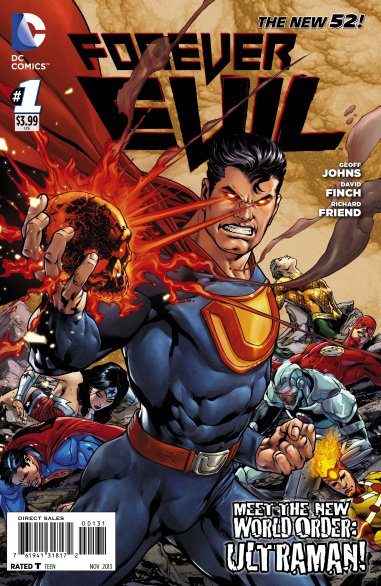 ‘Forever Evil’: Geoff Johns, David Finch conspire
‘Forever Evil’: Geoff Johns, David Finch conspire
‘Gotham’: Batman’s city to get series on Fox
‘Flash’ may get CW show; Geoff Johns co-writing back-door pilot on ‘Arrow’
‘Arrow’: Geoff Johns discusses his Starling City visit
Ben Affleck will play Batman opposite Henry Cavill’s Superman
Ben Affleck as Batman: Past roles that might inform his performance
Avengers at 50: How Stan Lee, Jack Kirby took on the Justice League
